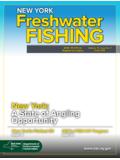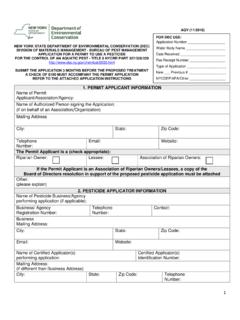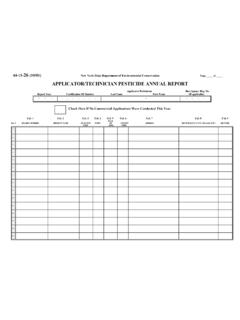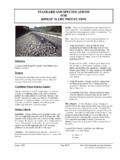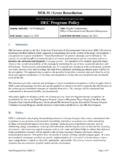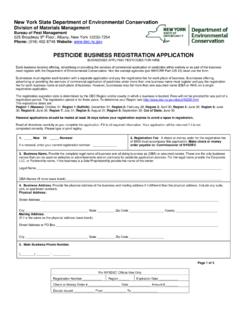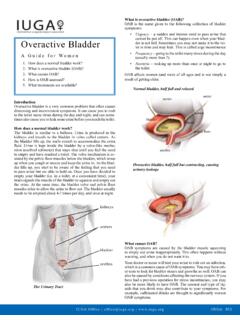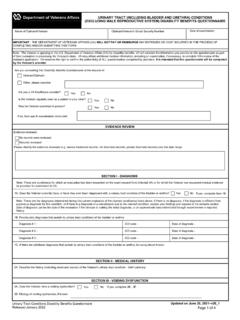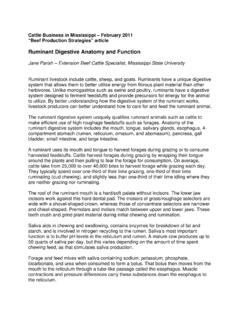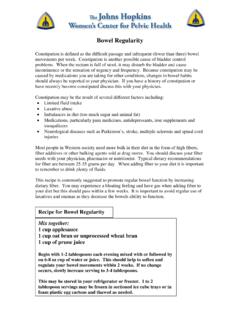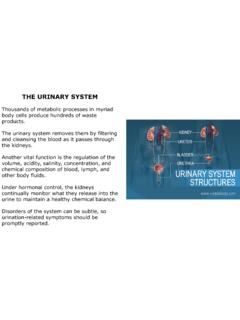Transcription of Fish Dissection Lesson Plan - New York State Department of ...
1 NYSDEC Region 1 Freshwater Fisheries I FISH NY Program NYSDEC Region 1 Freshwater Fisheries 2013 Page 1 Illustration by Duane Raver Fish Dissection Summary Living things are similar to and different from each other. When we look at the inside of a fish, we will learn that certain organs and systems in fish are similar to those in humans; and other organs and systems are not. Stomach contents can tell us much about a fish s habit. The external anatomical features (outside body parts) of fish can also tell us a lot about a species--where it lives in the water, how it finds food, and how it protects itself from predators.
2 Objectives The objectives are to create a dynamic hands-on experience to assist in understanding the internal organs and system functions of a local fish species; for students to understand the external body parts of fish; and to discuss both internal and external features in relation to the human anatomy. After this presentation, students will be able to: Identify 3-5 external anatomical features of a fish. Identify the major internal organs of a fish. Compare and contrast human and fish internal organs, structures, and systems. Materials 2 Fish for Dissection 2 scissors, scalpels, filet knives, or dissecting kits 2 dissecting trays or cutting boards Organ definition cards Hand sanitizer Laptop computer & projector Fish mounts, models or pictures Newspaper or protective table cover, 2 or more rags Box of plastic gloves (non-latex) Dissection Power Point presentation Dissection Worksheet Internal Anatomy Crossword Puzzle Grade Level(s): 6th 8th Time: 40-80 minutes Group Size: 20-30 students NYS Learning Standards Core Curriculum MST Living Environment: Standard 4 Students will.
3 Understand and apply scientific concepts, principles, and theories pertaining to the physical setting and living environment and recognize the historical development of ideas in science. Key Idea 1: Living things are both similar to and different from each other and nonliving things. Key Idea 4: The continuity of life is sustained through reproduction and development. Key Idea 5: Organisms maintain a dynamic equilibrium that sustains life. NYSDEC Region 1 Freshwater Fisheries I FISH NY Program NYSDEC Region 1 Freshwater Fisheries 2013 Page 2 Vocabulary Anal Fin - fin located near the anal opening; used for balance and steering.
4 Caudal or Tail Fin - fin at the tail of a fish; used for propulsion. Circulatory System - delivers blood and oxygen throughout the body via the heart. Digestive System breaks down and processes proteins, carbohydrates and fats. Dorsal Fin backside (top) fin on a fish; used for balance and protection. External Anatomy - the outside body parts, such as, fins, scales, mouth. Gills organ used to obtain oxygen from the water and rid carbon dioxide. Gill Rakers filter feed tiny prey; appendages along the front edge of the gill arch. Gonads the sex organs; males have testes, females have ovaries.
5 Some fish are hermaphroditic, meaning having both sets of gonads (male & female) in one fish. Lateral Line organ of microscopic pores that sense low vibrations and water pressure. Nares - organ to smell; similar to nostrils. Nervous System - organs receiving and interpreting stimuli for nares, eyes, lateral line, muscles, and other tissues. Pectoral Fin - fins on the sides; used for balance and assist turning. Pelvic Fin - belly fins on a fish; used for balance and steering. Pyloric Caece finger-like organ that aids in digestion, using bile from the liver. Reproductive System the organs and tissues involved in reproduction, including gonads, eggs, sperm.
6 Respiratory System organs and tissues involved in the oxygen & carbon dioxide gas exchange, including gills, gill rakers, and gill filaments. Scales - protective cover on a fish; similar to skin. Slime slippery covering on scales, protecting fish from bacteria, parasites, etc. Swim bladder found only in ray-finned fish; a double sac used to assist in buoyancy. Urinary System the kidneys remove nitrogen (ammonia) from the blood and regulate water balance in the blood and tissues. Vertebrate an organism with a backbone or spine. Vocabulary words will show up once in bold Background Fish and other vertebrates have much in common with humans.
7 Many of the systems and organs are the same. Yet there are many unique differences in the organs and their functions in fish, and even between fish species. This Lesson will be one for inquisitive exploration, and hands-on learning. NYSDEC Region 1 Freshwater Fisheries I FISH NY Program NYSDEC Region 1 Freshwater Fisheries 2013 Page 3 Internal Anatomy Heart This organ pumps blood throughout the body delivering oxygen and digested nutrients to the cells of various organs. It transports waste products from the cells to the kidneys and liver for elimination. In fish, the circulatory system is a single circuit, with a 2-chambered heart, unlike the typical 4-chambered heart found in land animals like mammals and birds.
8 From the fish s atrium blood is pumped into the ventricle of the heart. From the ventricle, blood is pumped to the gills where gas exchange takes place in the gill filaments. Carbon dioxide (CO2) is expelled and oxygen (O2) is taken in. This re-oxygenated blood then flows on to the rest of the body s tissues and organs removing carbon dioxide and replacing it with life-giving oxygen. Blood is finally pumped back to the heart s atrium chamber where the process begins again. Liver The liver has many digestive and storage functions. One is the production of bile, a solution which emulsifies or breaks down fats in the intestine.
9 The liver also stores fats and carbohydrates, destroys old blood cells, maintains proper blood chemistry, and plays a role in nitrogen waste removal. Pyloric Caeca This organ with finger-like projections is located near the junction of the stomach and the intestines. It is thought that through the secretion of enzymes it assists in breaking down the food further and absorbs needed nutrients, yet the function of this organ is still not well understood. Gonads Gonads are the sex organs. Males have paired testes that produce sperm, and females have paired ovaries that produce eggs. In most cases, fertilization of the eggs is performed externally, called spawning.
10 Swim bladder Most fish have an organ called the swim bladder . It is a flexible, gas-filled sac located in the dorsal or top portion of the body cavity and helps to control the fish's buoyancy. Since fish have a density that is heavier than water, they need this swim bladder to not sink when they stop swimming. There are two types of swim bladders, the physostomous and physoclistous. Fish with a physostomous swim bladder are usually found in shallow water, though some are in deeper water. They will expel bubbles as they swim closer to the surface of the water and then they will swallow air at the surface before diving back down into the water.
